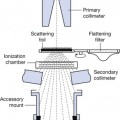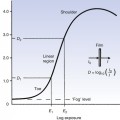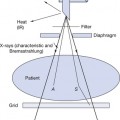Chapter 43 Mammography
Chapter contents
43.1 Aim
The aim of this chapter is to explore the modifications of standard X-ray tubes which are specifically designed to image breast tissues. The physics of X-ray beams consisting of a narrow range of low-energy photons is described, since these beams emphasize photoelectric absorption differences between soft tissues.
43.2 Introduction
X-ray mammography depends upon the ability to display small-density and atomic number differences between soft tissues. This particularly applies to the microcalcifications which can be an early sign of breast carcinoma. So thousands of symptomatic women and those participating within breast screening programmes rely upon X-ray physics to provide an accurate diagnosis. Conventional radiography, which uses X-ray tubes with tungsten targets (see Ch. 30) and tube kilovoltages of 40 and upwards, has difficulty in showing small soft tissue differences. This situation has been somewhat improved with the advent of high-resolution digital imaging methods which provide a wide ‘dynamic range’ of signal intensities, but despite this advancement, alternative techniques must be employed to demonstrate breast pathologies. These consist of microcalcifications and altered soft tissue densities in glandular, lactiferous and fatty structures. Mammography X-ray units must be compact and maneuverable in order to image all parts of the breast, including the axillary tail.
43.3 Tissue X-ray attenuation challenges for breast imaging
Atomic number differences (calcification ≈14, water ≈7, fat ≈6) can be accentuated using photoelectric attenuation of X-rays (see Ch. 23) which predominates at low X-ray photon energies, and is directly proportional to atomic number cubed (∝ Z3). It is also known that photoelectric absorption is inversely proportional to X-ray energy cubed (∝ 1/E3). Thus the keV values (energy values) of X-ray photons must be very small if they are to experience much photoelectric attenuation in the low atomic number soft tissues of the breast. A good source of low keV X-ray photons is required, without producing rays which are of such very low energy that they will be absorbed in the skin and increase radiation dose. Although it will never be possible to produce a purely monoenergetic (single energy) X-ray beam, since the Bremsstrahlung process of X-ray production provides a continuous X-ray spectrum (see Ch. 21), it would be ideal of we could produce a ‘narrow band’ X-ray spectrum, with the bulk of X-rays being found across a small range of energies. This would reduce radiation dose to the breast and also enhance X-ray absorption differences between tissues, increasing image contrast.
43.4 X-ray beam adaptations for breast imaging
The requirements for a narrow and low beam energy range for mammography can be met in part by using molybdenum rather than tungsten as an X-ray tube target material. Some of the key properties of tungsten and molybdenum are summarized in Table 43.1.
Table 43.1 Features of tungsten and molybdenum targets for X-ray production
Stay updated, free articles. Join our Telegram channel

Full access? Get Clinical Tree








